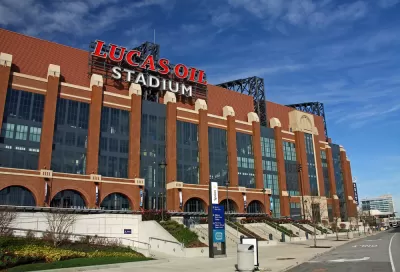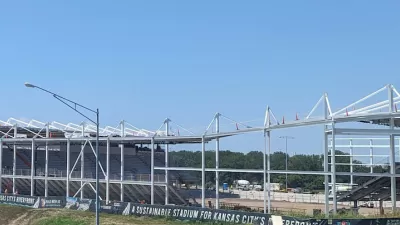Are you ready for some football…stadiums to receive massive subsidies from the federal government?

Ted Gayer, Austin J. Drukker, and Alexander K. Gold write a blog post introducing a new paper on the federal subsidies devoted to private sports stadiums in the United States.
The article opens with the example set by the house that replaced the "House that Ruth Built": the new Yankee Stadium that opened in 2009. The stadium received $1.7 billion in tax-exempt municipal bonds, which amounts to a $431 million federal subsidy. The stadium's financing is also responsible for another $61 million in lost federal tax revenues: "High-income taxpayers holding the bonds receive a windfall tax break, resulting in an even greater loss of revenue to the federal government."
The new paper by the Brookings team finds 35 examples of tax-exempt bond financing of professional sports stadiums since 2000.
All together, the federal government has subsidized newly constructed or majorly renovated professional sports stadiums to the tune of $3.2 billion federal taxpayer dollars since 2000. But because high-income bond holders receive a windfall gain for holding municipal bonds, the resulting loss in total revenue to the federal government is even larger at $3.7 billion.
The article also includes an interactive menu of federal financing for stadiums, with stadiums from Major League Baseball, the National Football league, the National Basketball Association, an the National Hockey league included.
The study also recommends a way to end the subsidy gravy train for private sports stadiums: eliminate the private payment test for stadiums. "By doing so, any stadium used primarily for 'private business use' (that is, all professional sports stadiums) would no longer be eligible to receive federal tax-exempt financing," according to the article.
FULL STORY: Why the federal government should stop spending billions on private sports stadiums

Planetizen Federal Action Tracker
A weekly monitor of how Trump’s orders and actions are impacting planners and planning in America.

San Francisco's School District Spent $105M To Build Affordable Housing for Teachers — And That's Just the Beginning
SFUSD joins a growing list of school districts using their land holdings to address housing affordability challenges faced by their own employees.

The Tiny, Adorable $7,000 Car Turning Japan Onto EVs
The single seat Mibot charges from a regular plug as quickly as an iPad, and is about half the price of an average EV.

Seattle's Plan for Adopting Driverless Cars
Equity, safety, accessibility and affordability are front of mind as the city prepares for robotaxis and other autonomous vehicles.

As Trump Phases Out FEMA, Is It Time to Flee the Floodplains?
With less federal funding available for disaster relief efforts, the need to relocate at-risk communities is more urgent than ever.

With Protected Lanes, 460% More People Commute by Bike
For those needing more ammo, more data proving what we already knew is here.
Urban Design for Planners 1: Software Tools
This six-course series explores essential urban design concepts using open source software and equips planners with the tools they need to participate fully in the urban design process.
Planning for Universal Design
Learn the tools for implementing Universal Design in planning regulations.
Smith Gee Studio
City of Charlotte
City of Camden Redevelopment Agency
City of Astoria
Transportation Research & Education Center (TREC) at Portland State University
US High Speed Rail Association
City of Camden Redevelopment Agency
Municipality of Princeton (NJ)




























